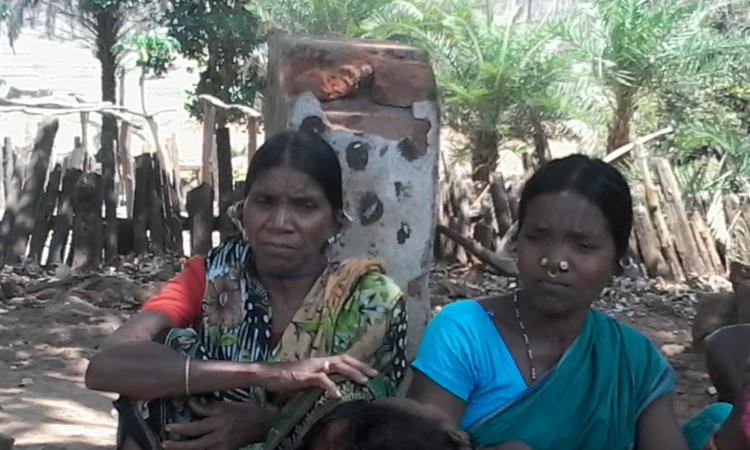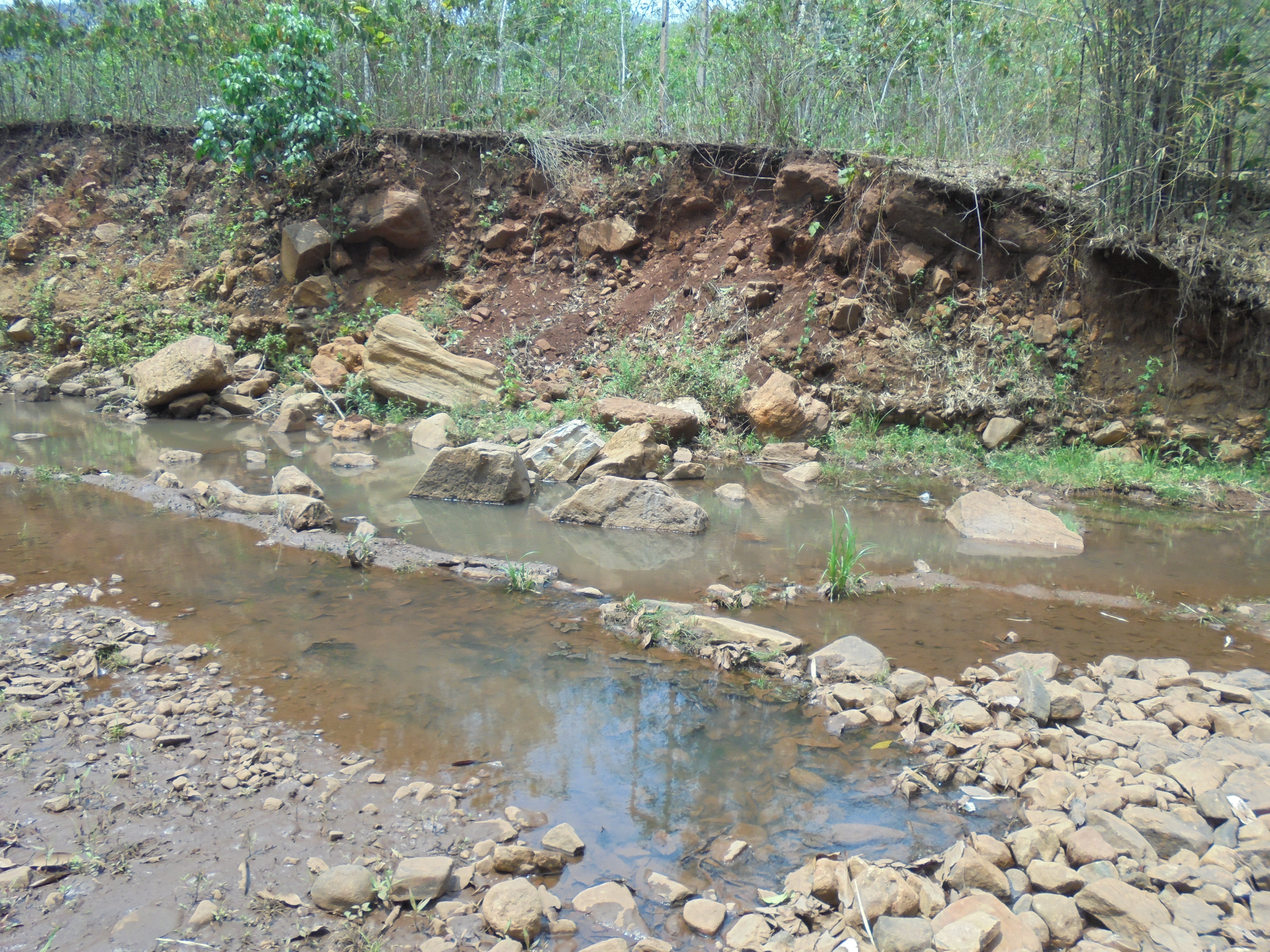
The Niyamagiri hills in the Eastern Ghats is peopled by indigenous groups such as the Dongria and Kutia Kondhs -- or 'primitive tribal groups’ in official phrasing. For them, these hills which spread over 300 sq kms in Rayagada and Kalahandi districts in southwestern Orissa, is the sacred abode of Niyamraja, their God.
Profund linkages exist here between the people, the forests and its waters. "The deep reverence that they have for their Gods, hills and streams pervades every aspect of their lives. Even their art reflects the mountains, in the triangular designs found on village shrines. They derive their name from Dongar, meaning ‘hill’ and their name is jharnia: protector of streams" (1).
The Kondhs' believe that everything in the wild has a life force or soul – jela drawn from dharni – their Mother Goddess. They live on the hilly slopes, which they farm, of course with the approval of the God of the hills. They survive on the hill’s produce – a variety of cereals, pulses and vegetables. They collect wild foods, fruits, fodder, herbs from the forests. They get wood for their agricultural implements and housing material from here.
The mountains bring them water

The Niyamagiri Hills are home to over a hundred streams. Vamsadhara and Nagavalli, two major rivers, sumptuously meander through these hills as well and along with their innumerable streams, rivulets and tributaries cater to the irrigation and drinking water needs of millions downstream in Orissa and Andhra Pradesh.
Indeed, some attribute the richness of the water and biodiversity to the bauxite reserves lying underneath. 'The Dongria clearly understand that the 70 million tons of bauxite reserves at the top of the Niyam Dongar act as a sponge that soak up the monsoon rains and then hold deposits of water throughout the hot summer months. These reserves ensure the continuous flow of perennial streams across the Niyamgiri hills (2).
Sadly, not everyone understands this entire picture. Or maybe they do but don't care.
Bauxite mining and the end of the Dongria and Kutia Kondhs way of life
Vedanta, a UK based mining giant, conceived one of the most destructive bauxite mining projects in recent times in India. The company hoped to extract around USD 2 billion worth of bauxite that lay hidden underneath Niyamagiri for its alumina refinery at Lanjigarh close by. The Orissa government was to only get Rs. 400 crore as royalty payment.
For mining purposes, about 723 hectares of land was required of which 233 hectares belonged to the indigenous people. As per the Government of India’s Panchayat (Extension to Scheduled Areas) Act of 1996 also known as PESA, these lands fell under ‘scheduled areas’. The Act enabled the gram sabhas in these areas to self govern their natural resources. The idea was to prevent the alienation of indigenous people’s lands in scheduled areas. Yet, the state and the company wanted to go ahead with their plans. If completed, 10,000-odd indigenous people would have lost their homes due to the mining.
The alumina refinery had already been built on 60 hectares of village forests without the mandatory clearances. The massive environmental and social impacts of the project were downplayed and the people displaced without adequate compensation (3).
The refinery pollutes
Earlier, in a contentious decision, the Supreme Court had allowed the refinery to be constructed in the foothills of Niyamagiri (4). It had no idea about the company’s plans. Very soon, the company tried to justify its case for mining on the grounds that it was already heavily invested in the refinery here.

Pollution from the refinery in the form of red mud toxic slurry (5) had begun damaging the crops and was harming human and animal health. The waste product was left to dry but often found its way into the rivers, streams and groundwater. An environmental inspection of the plant by the Orissa State Pollution Control Board reported water pollution by the plant including increasing the pH value of the river Vamshadhara below the refinery.
A conveyor belt was planned to carry the bauxite immediately from Niyamagiri to the refinery and the work on this had begun. Over a hundred odd cascading streams and a few major rivers flowing fast and free through the deep gorges would have been disrupted. Further, the government had made lot of investments on soil and water conservation through its Integrated Tribal Development Agency (ITDA), Soil Conservation Department, Lift Irrigation Department and National Watershed Development Mission through the years. All of this was expected to go down the drain in the event of mining from the area.
According to Dr Hariskrishna Tulo, "Statistics indicate that the income from mineral extraction rarely benefits the local people. In fact, poverty is increasing in many of these districts. The growth of the mineral sector in the state has led to many violent protests in Orissa. The state’s six million strong tribal population has borne the brunt of these environmental impacts. Mining has displaced about 5 lakh people in the state, mostly tribals. The Government’s argument that the new industries would provide employment is just a chimera. Between 1999 and 2005, the value of mineral production in the state increased three fold and at the same time, employment reduced by 20 per cent" (6).
Protests begin

In 2009, protests erupted and thousands of people formed a human chain around the hills. The project got the boot in 2010 when the Ministry of Environment and Forests (MoEF), Government of India did an about face on its environment clearances. Even then, the Minister, MoEF agreed that ‘there has been a very serious violation of the Environment Protection Act, the Forest Conservation Act and the Forest Rights Act’ (6).
The struggle reached an inflexion point due to local and international pressure (7). The proposed mining project in the area was put on hold as the people of the hills rejoiced. The Supreme Court in 2013 directed that the people of Niyamagiri would decide whether they wanted to allow the area to be mined. The people said "no"!
The sacred hills may have been saved but the battle may not be over yet, according to activist Satya Pattnaik. Vedanta still hopes that the decision will be reversed (8). The Niyamagiri Susraksha Samiti, the citizen’s body that led the movement, continues to be vigilant of the moves of the state and the mining lobby.
The people want that the MoEF follow some minimum standards when dealing with the diversion of forest land or the dislocation of forest dependent communities in scheduled areas. Going soft on those who flout environmental and forest conservation laws are unacceptable to them. They want the government to put a stop to human rights violations in the proposed project area. It should instead come up with planned and sustainable initiatives for social and environmental development in the area.
Meanwhile, the hills and waters of Niyamagiri get a temporary reprieve.
Endnotes and references
(1) Dongrias's, Survival international
(3) Siddhartha Mitra, Smoke hangs over Niyamgiri: A travelogue, 2012
(4) Supreme court judgement, 2011
(5) Red mud is a mix of highly toxic alkaline chemicals and heavy metals including radioactive element – in case of spill heavy metals and chemicals are likely to leach into groundwater.
(6) Save Niyamgiri Save Lives, Seba Jagat and National Adibasi Alliance, 2009
(7) Neha Sethi, Government rejects Vedanta's bauxite mining plans in Niyamgiri, 2014
(8) Ashish Kothari, Revisting the legend of Niyamagiri, The Hindu, 2015
/articles/niyamagiri-hills-get-temporary-respite-vedanta